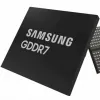GDDR (Graphics Double Data Rate) memory, originally known as DDR SGRAM (Double Data Rate Synchronous Graphics RAM), is crucial for high-performance computing applications, especially in graphics processing and artificial intelligence. The development of GDDR7 marks a considerable advancement in memory technology, reflecting a continued evolution from the initial announcement. The ISSCC 2024's session on High-Density Memory and Interfaces will include a focus on GDDR7, specifically discussing a "16Gb 37 Gb/s GDDR7 DRAM with PAM3-Optimized TRX Equalization and ZQ Calibration," which will delve into the technical enhancements of this new standard.
GDDR7 employs PAM3 (Pulse Amplitude Modulation 3) and NRZ (Non-Return-to-Zero) signaling to reach up to 37 Gbps per pin. This advancement is part of an ongoing effort to increase data rates and burst sizes without significantly impacting the internal clocks of memory cells, thereby improving memory bus frequencies and overall performance. The transition from GDDR6 to GDDR7 involves notable innovations. For instance, while GDDR6X introduced PAM4 encoding to double data rates and reduce signal losses, GDDR7 adopts PAM3 encoding. This method offers a compromise between PAM4 and NRZ, allowing for higher data transmission rates per cycle without necessitating higher memory bus frequencies. Consequently, GDDR7 is expected to outperform GDDR6 in terms of efficiency and cost-effectiveness compared to GDDR6X.
Further enhancing its efficiency, GDDR7 introduces features such as four distinct read clock modes for operation only when needed and the capability for two independent commands to be issued in parallel, optimizing both memory efficiency and power consumption. Projected to align with forthcoming GPU releases from AMD and NVIDIA, GDDR7 is anticipated to be a key component in the next generation of graphics technology.
Source: TechRadar

